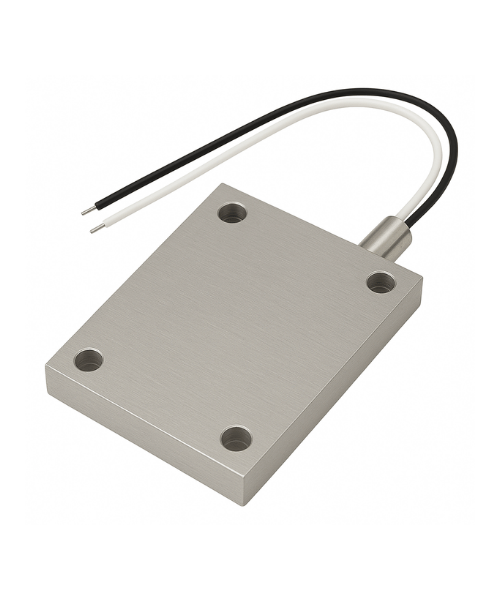Plate heaters
Elemente de caldamento a una o más conductores de caldamento (geradores tubulares) se immersão en un corpo de aluminio, acero inoxidable ou de messos. This design allows the heat to be evenly distributed over the entire surface of the plate and protects the heater from mechanical damage.
Owing to the good thermal conductivity of the metal, the heat from the heating elements is quickly transferred to the entire plate - without local overheating. Este es importante en pêvajoyên ku germahiya divê bi domdarî were domandin, mînakî di çêkirina plastîkê, germkirina miran, tabloyên xebatê an plakên germ ên di amûrên laboratuarê de.
The metal block acts as a thermal buffer: Gives off heat evenly and maintains temperature even with short-term power outages.
Plate heaters are chosen where it matters:
— temperature stability (no fluctuations on the surface),
— resistance to compression, impact and daily mechanical stress,
— can be mounted on large, flat surfaces.
Basic technical parameters
Heater cross section:
AISI 304, aluminum, brass
Industries
Specification
- Food industry — heating of worktops, maintaining the temperature of chocolate and fatty masses, heating of containers and tanks with products, heating of sealing jaws in packaging machines.
- Chemical industry — heating of tanks and reactors, temperature stabilization of chemical substances, prevention of solidification or thickening of liquids, heating of transport lines of substances.
- Plastics industry — heating of injection molds, maintaining the temperature of the dies, supporting the thermoforming process, heating the plastic elements before further processing.
- Pharmacology/Pharmaceutical industry — sterilisation and drying of surfaces, heating of tanks with liquids or ointments, temperature control in the process of tableting and encapsulation.
- Foundry industry — heating of casting molds, stabilizing the temperature of casting tools, heating dies before flooding with metal.
- Automotive industry — heating of moulds for the production of plastic and rubber elements, heating of mounting mats, temperature stabilization during gluing and lamination.
- Furniture industry — heating presses for veneers and veneers, heating or joinery adhesives, drying and curing of laminates.
- Paper industry — heating drying rolls, heating laminating adhesives, maintaining the temperature of cutting and paper processing machines.
- Electronics industry —,,.
- Packaging industry — heating of sealing jaws, heating of shrink films, maintaining the temperature of adhesives for labeling.
- Footwear industry — heating of molds for modeling soles, heating elements during gluing, stabilizing the shape of shoe elements.
- Textile industry — pressi di caldamento per stampa e laminazione, caldamento o calendari, risparazione di temperatura nel processo di impregnativo.
- Wood industry — heating of moulds for bending wood, drying of wooden elements, heating presses for gluing sandwich panels.
- Ceramic and glass industry — heating of worktops, heating of casting molds, maintaining the temperature of enamel and ceramic masses.
- Rubber Products Industry/Rubber Industry — heating of forms for vulcanization, heating of rubber compounds, temperature stabilization in the molding process.
- Railway and tramway industry/ Railway industry — heating of assembly stations, heating of rubber and plastic components, protection of the installation against freezing.
- Aerospace — heating of composite molds, temperature stabilization of mounting elements, heating of test surfaces.
- Metallurgical and metalworking — heating of sheets before bending or stamping, heating of tools and dies, heating of process lines.
- Reinforcement industry — heating of elements for gluing and assembly, stabilization of temperature conditions during the production of special components, heating of molds for composites.
- Energy and power plants/Power industry — heating of tanks with oils and lubricants, protection of the installation against freezing, heating of control cabinets.
- Home Appliance Industry — testing of the thermal resistance of components, heating of housings and moulds in the assembly process, temperature stabilization during production.
- Shipbuilding and offshore industry/Shipbuilding — heating of composite hull forms, heating of cables and pipes, protection of equipment against the effects of low temperatures.
- Industrial automation — heating elements of production lines, temperature stabilization of sensors and valves, heating or controller housings.
- Road and transport infrastructure — heating or metering systems, heating of road devices in winter, protection of electronics from frost.
- Cosmetic industry — heating waxes for depilation, maintaining the temperature of creams and oils, heating molds for lipsticks and soaps
- Medical industry and medical equipment manufacturing — heating of moulds for masks and prostheses, heating of liquids in laboratory equipment, temperature stabilization or incubators
- HVAC Industry — heating of air ducts, heating of ventilation units, protection of pipes from freezing
- Brewing industry and beverage production — heating of fermentation vats, temperature stabilization of tanks, heating of filling lines
- Recovery industry — heating of the plastic melting line, heating of waste containers, drying of materials
- Printing/printing industry — heating of rollers in printers, heating of ink and inks, heating or dies for UV printing
- Research and R&D Laboratories — heating of samples, temperature stabilization in tests, heating of test surfaces
- Event and stage industry — heating of stage equipment, heating of structural elements, stabilization of lighting temperature
- Mobile catering industry (food trucks) — maintaining the temperature of dishes, heating containers with sauces and side dishes
- In plate heaters it is possible to use a temperature sensor:
- Thermocouple type J (up to 650°C) *
- Thermocouple type K (up to 1000°C) *
La temperatura especificada a la temperatura maximum de la sensor y no el calador
(for each drawing)
- Wires
- Iron plug
- connection box
- M5 skruv
drawing and adding additional heating zones with a simple heater.
It is possible to make heaters with uneven distribution of turns, in order to obtain the desired distribution of thermal power.



